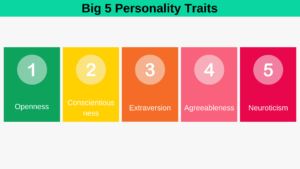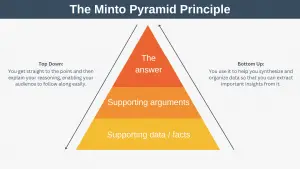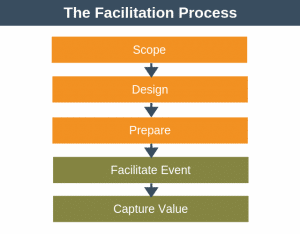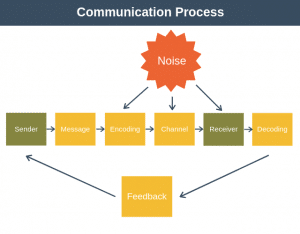Lewicki and Hiam’s Negotiation Matrix is a tool that can help you become a better negotiator.
It works by helping you to choose the best negotiation strategy for any situation. The tool doesn’t guarantee that you’ll get the outcome you want, but it will help you to approach the negotiation in the right way.
In the workplace, negotiation skills are useful every day. Yes, it could be that you’re negotiating a billion-dollar business deal, but negotiation skills are also helpful for everyday tasks such as:
- Salary negotiations.
- Agreeing on a deadline with your boss.
- Solving conflicts within your team.
- Allocating responsibilities to your team members.
- Dissipating potentially explosive differences of opinion within your team.
- Agreeing on suitable vacation dates with a team member.
- Deciding on whether to order pizza or tacos if your team is working late.
In short, if you work in a team containing more than one person, having strong negotiation skills will help you achieve the outcomes you want. Additionally, as a skilled negotiator, you’ll often be able to achieve win-win results where the other party is happy too.
Having good negotiation skills won’t just impact your success in the workplace; it will also affect your happiness.
What is Negotiation?
Negotiation occurs any time two or more people come together to resolve a difference of opinion.
In any negotiation, you will aim to reach a satisfactory outcome from your perspective. Sometimes you’ll need to make compromises along the way to achieve a good result, but not always.
If you manage a team, then regular negotiation around responsibilities, targets, and deadlines must be agreed to everyone’s satisfaction where possible. In this way, you will keep the goodwill of your team members and not disenfranchise them.
To Fail to Plan is to Plan to Fail
Benjamin Franklin famously said:
If you fail to plan, you are planning to fail!
And this is especially true when it comes to undertaking any serious negotiation that is important to you or your organization. In fact, according to Leigh Thompson, author of the 2009 book, “The Mind and Heart of the Negotiator,” roughly 80% of a negotiator’s effort should be invested in the preparation stage.
Here are some steps to undertake when preparing for a negotiation:
- Have a clear goal: work out exactly what it is that you’re actually after.
- Concessions: work out what compromises you’re prepared to make to achieve what you want.
- Scenarios: What other options might be available as an alternative outcome if you can’t achieve your goal?
- Leverage: Understand your power versus the power of your counterparty.
- Authority: Set very clear limits on what you do and do not have the authority to agree.
- Choose your negotiation approach: Many people wrongly assume that there is just one “best” way to negotiate. This isn’t the case, and it’s essential to choose your approach based upon the unique situation of your negotiation. This is the purpose of Lewicki and Hiam’s Negotiation Matrix: to help you select your negotiation approach.
The Negotiation Matrix
The Negotiation Matrix first appeared in a book entitled “Mastering Business Negotiation” by Roy Lewicki and Alexander Hiam.
It’s a tool you should use before you enter negotiations with your counterparty. The tool works by helping you choose the best negotiation strategy based on your priorities.
The Negotiation Matrix can be seen in the diagram below.
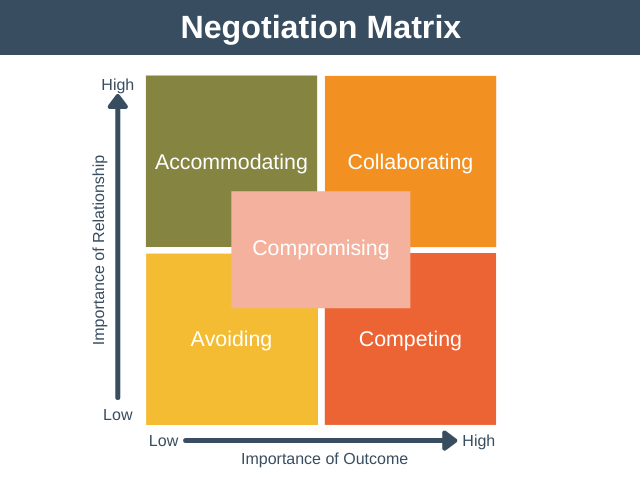
According to the model, you choose your negotiation strategy based upon two factors:
- The importance of the outcome: how important substantive results are, such as money, time, accomplishment, etc.
- The importance of the relationship: how important relational outcomes are, such as building or maintaining your relationship with the counterparty.
According to how you rank these two factors, the Negotiation Matrix suggests one of five approaches to your negotiation.
1. Avoiding (lose-lose)
If neither the relationship nor the substantive outcomes are important to you, then the negotiation isn’t worth entering into at all.
This negotiating strategy is also known as “lose-lose” because you have nothing to gain from the outcome or the relationship – it isn’t possible for anything of value to come from the negotiation.
You implement this strategy by withdrawing from active negotiation or avoiding the negotiation altogether. It simply isn’t worth investing your time into any discussion.
2. Accommodating (lose-to-win)
If your relationship with your counterparty is more important than the outcome, then you use this negotiation strategy. You can find this strategy in the upper left side of the Negotiation Matrix.
With this strategy, you choose to be relaxed about the outcome in order to maintain or build your relationship.
This negotiating strategy is also known as “lose-to-win” because you deliberately “lose” on the outcome dimension to “win” on the relationship dimension.
3. Competing (win-lose)
When the outcome is more important to you than the relationship, you may decide to negotiate hard for what you want, even if that results in your counterparty not getting what they want, and the relationship is damaged.
You use this strategy when you want to win at all costs. This strategy is known as “win-lose” because you win the outcome but lose the relationship. You can find this strategy at the bottom right of the Negotiation Matrix.
In this strategy, you are solely focused on what you get out of the situation.
4. Collaborating (win-win)
In the upper right of the Negotiating Matrix, you will find the Collaborating strategy, appropriate for when both the outcome and relationship are important.
This is called a “win-win” approach as the aim is to collaboratively work together until everyone gets what they want and so everyone is happy. Creative problem solving will be needed to find win-win solutions, and you must invest to build or maintain trust.
You use this approach when both parties have a lot to gain from a successful outcome, and you also want the ensure the relationship thrives over the long term. If your counterparty has as much to gain as you, they also have an incentive to work hard to achieve a mutually beneficial outcome.
5. Compromising (split the difference)
In the middle of the Negotiation Matrix is the Compromising strategy.
This strategy is used when both the substantive outcome and relationship are important, but for whatever reason, collaboration is not an option.
The aim of a compromise negotiation is that all parties give up a bit of what they want so that everyone gets at least a little of what they want; that is, they “split the difference.” There may be some damage to the relationship, but the aim is to keep this to a minimum.
Negotiation Matrix Examples
Let’s look at a few Negotiation Matrix examples to see how you might approach different negotiation scenarios in the real world.
Example 1:
You have been asked to negotiate a new deal with a supplier to provide new desks and chairs for your office.
Approach: In this scenario, the desks and chairs you are interested in could likely be supplied to you by any one of several local suppliers. Because you can choose from several suppliers, the relationship is not important to you. However, you are focused on getting the best price. In this scenario, you would choose the Competing negotiation strategy.
Example 2:
Again, you have been asked to negotiate with a supplier. But this time, they are your biggest supplier and difficult to replace. Likewise, you are one of their biggest customers.
Approach: In this scenario, the outcome is important but so is maintaining the relationship for the long term. In this case, it makes sense to use a Collaboration strategy.
Example 3:
You have been asked to manage a minor project. Unfortunately, a key person you require to complete the project doesn’t report to you, but another manager, who also needs to use this person to achieve their objectives, that of delivering a much more important project.
Approach: As your project is significantly less critical to your organization than your counterparty’s project, in this scenario, you might decide to adopt an Accomodating approach to negotiation, whereby you sacrifice achieving your objectives to allow the more important project to succeed. Of course, it would be a good idea to discuss this approach with your boss to ensure they are happy with it.
Summary
Lewicki and Hiam’s Negotiation Matrix is a tool to use before you enter a negotiation that can help you decide on a negotiation strategy.
The tool works by considering two factors: the importance of the outcome to you and the importance of your relationship with your counterparty.
The tool won’t guarantee that you achieve the outcomes you’re hoping for, but it will help you approach the negotiation in the right way.
